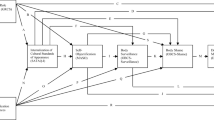Abstract
This study was designed to test the extent to which women who self-objectify also objectify other women. One hundred thirty-two university students and their friends (64 women and 68 men) completed three questionnaires: (1) Noll and Fredrickson’s (1998) Self-Objectification Questionnaire, (2) a modified version of that questionnaire that measured individuals’ objectification of others, and (3) Slade, Dewey, Newton, and Brodie’s (1990) Body Cathexis scale. Women were more likely than men to self-objectify. Self-objectification was negatively related to body satisfaction for women but not for men. Both women and men objectified women more than they objectified men, although women’s objectification of other women was not significantly different than their objectification of men. Men objectified women more than women did, and women objectified men more than men did. Women were more likely to objectify other women than to objectify themselves. Higher self-objectification among both women and men was related to increased objectification of other women and men, but the relationships were stronger for women. Results indicate that women also objectify women, although not to the degree exhibited by men.
Similar content being viewed by others
References
Beebe, D. W., Hombeck, G. N., Schober, A., Lane, M., & Rosa, K. (1996). Is body focus restricted to self-evaluation? Body focus in the evaluation of self and others. International Journal of Eating Disorders, 20, 415–422.
Fredrickson, B. L., & Roberts, T.-A. (1997). Objectification theory: Toward understanding women’s lived experiences and mental health risks. Psychology of Women Quarterly, 21, 207–226.
Fredrickson, B. L., Roberts, T.-A., Noll, S. M., Quinn, D. M., & Twenge, J. M. (1998). That swimsuit becomes you: Sex differences in self-objectification, restrained eating, and math performance. Journal of Personality and Social Psychology, 75, 269–284.
Furnham, A., Badmin, N., & Sneade, I. (2002). Body image dissatisfaction: Gender differences in eating attitudes, self-esteem, and reasons for exercise. Journal of Psychology, 136, 581–596.
McCreary, D. R., & Sasse, D. K. (2001). Exploring the drive for muscularity in adolescent boys and girls. Journal of American College Health, 48, 297–304.
McKinley, N. M. (1998). Gender differences in undergraduates’ body esteem: The mediating effect of objectified body consciousness and actual/ideal weight discrepancy. Sex Roles, 39, 113–123.
McKinley, N. M. (2002). Feminist perspectives and objectified body consciousness. In T. F. Cash & T. Pruzinsky (Eds.), Body Image: A Handbook of Theory, Research, and Clinical Practice (pp. 55–62). New York: Guilford.
McKinley, N. M., & Hyde, J. S. (1996). The Objectified Body Consciousness Scale: Development and validation. Psychology of Women Quarterly, 20, 181–215.
Noll, S. M., & Fredrickson, B. L. (1998). A mediational model linking self-objectification, body shame, and disordered eating. Psychology of Women Quarterly, 22, 623–636.
Polivy, J., & Herman, C. P. (1985). Dieting and binging: A causal analysis. American Psychologist, 40, 193–201.
Polivy, J., & Herman, C. P. (2002). Causes of eating disorders. Annual Review of Psychology, 53, 187–213.
Richards, M. H., Caspar, R. C., & Larson, R. W. (1990). Weight and eating concerns among pre- and young adolescent boys and girls. Journal of Adolescent Health Care, 11, 85–89.
Rieder, S., & Ruderman, A. (2001). Cognitive factors associated with binge and purge eating behaviours: The interaction of body dissatisfaction and body image importance. Cognitive Therapy and Research, 25, 801–812.
Secord, P. F., & Jourard, S. M. (1953). The appraisal of body-cathexis: Body-cathexis and the self. Journal of Consulting Psychology, 17, 343–347.
Slade, P. D., Dewey, M. E., Newton, T., & Brodie, D. A. (1990). Development and preliminary validation of the Body Satisfaction Scale (BSS). Psychology and Health, 4, 213–220.
Stice, E. (1994). Review of the evidence for a sociocultural model of bulimia nervosa and an exploration of the mechanisms of action. Clinical Psychology Review, 14, 633–661.
Strelan, P., Mehaffey, S. J., & Tiggemann, M. (2003). Self-objectification and esteem in young women: The mediating role of exercise. Sex Roles, 48, 89–95.
Tiggemann, M., & Lynch, J. E. (2001). Body image across the lifespan in adult women: The role of self-objectification. Developmental Psychology, 37, 243–253.
Thompson, J. K., Heinberg, L. J., Altabe, M., & Tantleff-Dunn, S. (1999). Exacting beauty: Theory, assessment, and treatment of body image disturbance. Washington, DC: American Psychological Association.
van den Berg, P., Thompson, J. K., Obremski-Brandon, K., & Coovert, M. (2002). The tripartite influence model of body image and eating disturbance: A covariance structure modelling investigation testing the meditational role of appearance comparison. Journal of Psychosomatic Research, 53, 1007–1020.
Author information
Authors and Affiliations
Corresponding author
Rights and permissions
About this article
Cite this article
Strelan, P., Hargreaves, D. Women Who Objectify Other Women: The Vicious Circle of Objectification?. Sex Roles 52, 707–712 (2005). https://doi.org/10.1007/s11199-005-3737-3
Issue Date:
DOI: https://doi.org/10.1007/s11199-005-3737-3




